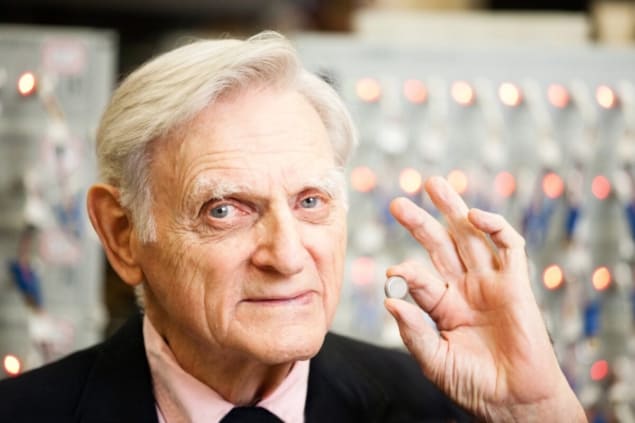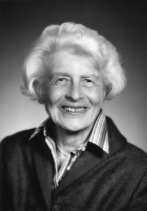
The materials scientist John Goodenough, who pioneered the development of lithium-ion batteries, died on 25 June at the age of 100. Goodenough’s work, which he led in the 1970s and 1980s, went on to power a revolution in handheld electronics and electric vehicles. He was awarded a share of the 2019 Nobel Prize for Chemistry, when he became the oldest ever Nobel laureate at the age of 97.
Born in Jena, Germany, on 25 July 1922 to American parents, Goodenough received a BS in mathematics from Yale University in 1944. After serving as a meteorologist for the US Army during the Second World War, he was awarded a PhD in physics from the University of Chicago in 1952.
After his doctorate, Goodenough went to the Massachusetts Institute of Technology’s Lincoln Laboratory where he mostly worked on random-access memory used in computers. In 1976 he moved to the University of Oxford in the UK, where he led the development of lithium-ion rechargeable batteries.
Powering a revolution
At the time, Stanley Whittingham from Stanford University had been developing new energy systems when he discovered that a battery cathode made of titanium disulphide can absorb lots of lithium ions from a metallic lithium anode.
Building on this finding, in 1979 Goodenough discovered that an even better performing cathode can be made from cobalt oxide. This work showed that it would be possible to achieve a high density of stored energy with an anode other than metallic lithium.
The trouble with metallic lithium is that while it is an excellent anode material because it readily gives up electrons, it is highly reactive. Akira Yoshino from the Asahi Kasei Cooporation solved this problem in 1985 by creating a carbon-based anode that is able to absorb large numbers of lithium ions.
This work removed the need to use reactive metallic lithium and the first commercial lithium-ion battery appeared in 1991. Since then, the devices have powered a revolution in handheld electronics and electric vehicles. It was for this work that Goodenough, Whittingham and Yoshino recieved the 2019 Nobel Prize for Chemistry.
Back in the US
In 1986 Goodenough returned to the US, joining the University of Texas at Austin where he was to remain for the rest of his career. In 2006 Goodenough established the John B and Irene W Goodenough Endowed Research Fund in Engineering at the university.

Beyond the lithium-ion battery
Goodenough is the author of eight books including Magnetism and the Chemical Bond, which was published in 1963. He also wrote an autobiography – Witness to Grace – in 2008. As well as the Nobel prize, Goodenough received many other awards including the Japan Prize in 2001, the Enrico Fermi Award (2009) and the US National Medal of Science (2011).
“John’s legacy as a brilliant scientist is immeasurable — his discoveries improved the lives of billions of people around the world,” says Jay Hartzell, president of the University of Texas at Austin. “He was a leader at the cutting edge of scientific research throughout the many decades of his career, and he never ceased searching for innovative energy-storage solutions.”
- SEO Powered Content & PR Distribution. Get Amplified Today.
- PlatoData.Network Vertical Generative Ai. Empower Yourself. Access Here.
- PlatoAiStream. Web3 Intelligence. Knowledge Amplified. Access Here.
- PlatoESG. Automotive / EVs, Carbon, CleanTech, Energy, Environment, Solar, Waste Management. Access Here.
- BlockOffsets. Modernizing Environmental Offset Ownership. Access Here.
- Source: https://physicsworld.com/a/john-goodenough-nobel-prize-winning-battery-pioneer-dies-aged-100/
- :is
- :where
- $UP
- 100
- 160
- 1985
- 2001
- 2006
- 2008
- 2011
- 2019
- 25
- a
- Able
- Achieve
- After
- age
- aged
- also
- American
- an
- and
- appeared
- ARE
- Army
- around
- AS
- At
- austin
- author
- award
- awarded
- awards
- batteries
- battery
- BE
- became
- because
- been
- Better
- billions
- brilliant
- by
- CAN
- Career
- chemical
- chemistry
- chicago
- CO
- Cobalt
- commercial
- computers
- Creating
- cutting
- decades
- developing
- Development
- Devices
- died
- discovered
- during
- Edge
- Electric
- electric vehicles
- Electronic
- Electronics
- electrons
- energy
- established
- Even
- EVER
- excellent
- finding
- First
- For
- from
- fund
- Germany
- gives
- Giving
- had
- Have
- he
- High
- highly
- his
- HTML
- HTTPS
- image
- improved
- in
- Including
- information
- innovative
- Institute
- issue
- IT
- Japan
- John
- joining
- jpg
- July
- june
- laboratory
- large
- lead
- leader
- Led
- Legacy
- Lincoln
- Lives
- made
- many
- massachusetts
- material
- materials
- mathematics
- max-width
- Memory
- Modern
- mostly
- moved
- National
- Need
- never
- New
- Nobel Laureate
- nobel prize
- now
- numbers
- of
- oldest
- on
- Other
- Oxford
- parents
- People
- performing
- Physics
- Physics World
- pioneer
- pioneered
- plato
- Plato Data Intelligence
- PlatoData
- possible
- power
- powered
- president
- prize
- Problem
- published
- received
- remain
- Removed
- research
- REST
- Revolution
- says
- Science
- scientific
- Scientist
- searching
- Second
- Second world war
- serving
- showed
- since
- Solutions
- stanford
- Stanford university
- stanley
- stored
- Systems
- texas
- than
- that
- The
- the UK
- the world
- then
- this
- throughout
- thumbnail
- time
- to
- trouble
- true
- ubiquitous
- Uk
- university
- University of Chicago
- University of Oxford
- us
- us army
- use
- used
- Vehicles
- W
- war
- was
- WELL
- went
- when
- which
- while
- WHO
- with
- Work
- worked
- world
- would
- zephyrnet













